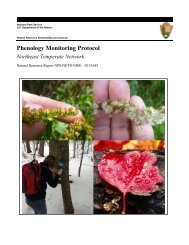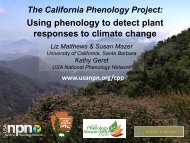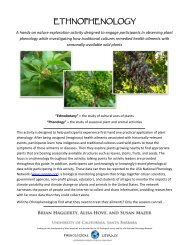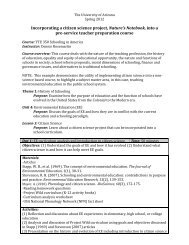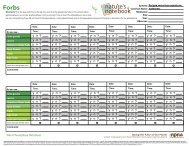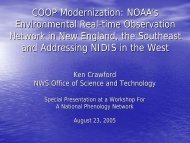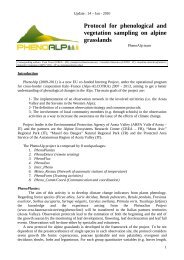The Phenology Handbook - USA National Phenology Network
The Phenology Handbook - USA National Phenology Network
The Phenology Handbook - USA National Phenology Network
You also want an ePaper? Increase the reach of your titles
YUMPU automatically turns print PDFs into web optimized ePapers that Google loves.
<strong>The</strong> <strong>USA</strong>-<strong>National</strong> <strong>Phenology</strong> <strong>Network</strong><br />
<strong>The</strong> <strong>USA</strong>-NPN is being designed as a nationwide network that oversees regularly repeated phenological<br />
observations that are linked to local and national climatological and hydrological data, as well as to imagery<br />
or data obtained through remote sensing. <strong>The</strong>se data, in turn, will be available for analysis using a<br />
variety of quantitative and geographic tools. <strong>The</strong> first objective of the <strong>USA</strong>- NPN is to establish a functional<br />
phenological monitoring network of stations distributed throughout the United States. Organizations<br />
such as biological field stations, agricultural extension stations, and <strong>National</strong> Parks, which already include<br />
biological monitoring as part of their current mission or ongoing activities, are particularly valuable institutional<br />
partners, as are schools and universities engaged in planting and monitoring local phenological<br />
gardens. Only with widespread engagement of the public, however, will the NPN be able to realize the<br />
kind of data-collecting power that will enable it to detect the species, communities, and biomes that are<br />
most sensitive to environmental change.<br />
<strong>The</strong> <strong>USA</strong>-<strong>National</strong> <strong>Phenology</strong> <strong>Network</strong> will consist of four tiers representing varying levels of sampling intensity.<br />
<strong>The</strong> first tier (top of the pyramid) comprises the most intensively monitored sites, where multiple<br />
environmental parameters are already being recorded. <strong>The</strong> second tier represents existing networks of<br />
people and/or instruments, such as weather stations, national parks, national forests, and wildlife refuges.<br />
<strong>The</strong> third, even broader, tier includes members of the public and formal and informal educational groups.<br />
For example, Project Budburst, a national campaign to engage the public in phenological monitoring, was<br />
successfully launched in 2007 and expanded in 2008. At the base of the observation pyramid are remotely<br />
sensed data, which can provide wall-to-wall coverage of observations across the landscape. Finally, focused<br />
phenology networks with local to regional objectives are also being developed with the support and<br />
guidance of the <strong>National</strong> Coordinating Office of the <strong>USA</strong>-NPN, which was established in Tucson, Arizona in<br />
summer 2007 with long-term support from the U.S. Geological Survey and the University of Arizona.<br />
26



